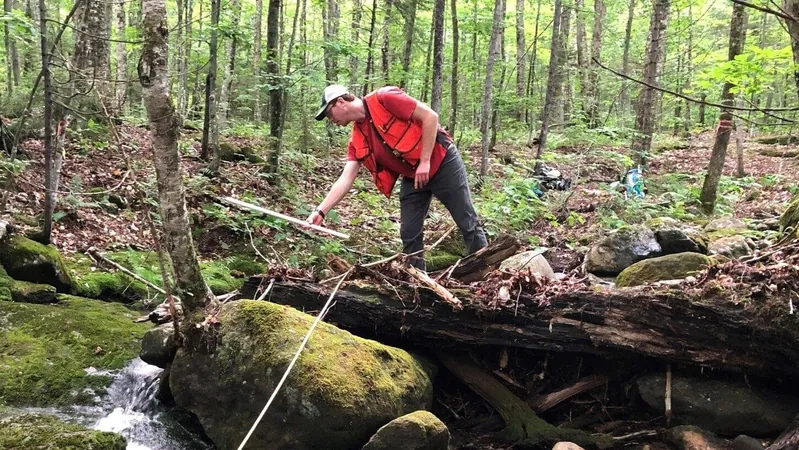
Dead Trees: The Surprising Carbon Heroes of Our Ecosystems
2025-03-31
Author: Rajesh
Introduction
Living trees are well-known for their ability to absorb carbon dioxide, playing a vital role in combating climate change. However, new research from the University of Vermont (UVM) reveals that dead trees, particularly large, fallen ones in aquatic ecosystems, are also key players in carbon storage—potentially more than previously understood.
The Role of Dead Trees in Carbon Sequestration
According to professor Dr. William Keeton, who led the study, about 20% of global greenhouse gas emissions stem from land use changes and deforestation. However, forests can also serve as ‘natural climate solutions’ by sequestering more carbon. Keeton posited that large pieces of wood in streams from old-growth forests could store significant amounts of carbon. And the verdict? They do, in astonishing quantities.
Key Findings on Carbon Storage
The lead author of the study, Stephen Peters-Collaer, a graduate student at UVM’s Rubenstein School of Environment and Natural Resources, indicated that old-growth forests contain four to five times more carbon stored in wood submerged in streams compared to mature forests. In comparison, the dead-wood carbon pool in streams of mature forests is notably larger—approximately 50% to 60% more than that found on the forest floor within the same area.
The Significance of Upland Streams
Despite their smaller size, upland streams, which comprise 70% of total river mileage, surprisingly reveal a critical but underexplored aspect of carbon storage. Peters-Collaer pointed out that there has been a growing consensus that wood in various aquatic systems stores carbon, yet no one had quantified this storage adequately—until now.
Research Methodology
This groundbreaking research was conducted at two key sites: the Hubbard Brook Experimental Forest in New Hampshire and the ancient forests of New York’s Adirondack State Park, both historically rich areas for ecological studies. Over three summers, researchers meticulously surveyed 4,500 meters of headwater streams, measuring the size of the wood present to estimate the carbon it contained and examining adjacent forest ecosystems.
Implications for Forest Recovery and Management
The study found that as forests evolve towards an old-growth status, they accumulate more wood in streams than is lost to decomposition. Peters-Collaer highlighted the importance of large trees in this process, as their presence contributes significantly to carbon storage.
Looking Ahead: Future of Carbon Sequestration
As the recovery of many mature forests in New England continues, following significant deforestation in the 19th and 20th centuries, researchers anticipate an increase in carbon sequestration well into the future. Keeton estimates that as these forests age, they will continue to enhance their carbon pools—prominently influencing global carbon models and contributing to our understanding of natural climate solutions.
Conclusion and Practical Implications
For landowners in Vermont, where 80% of forested land is privately owned, these findings are crucial. They underscore the potential for incorporating carbon storage strategies into land management practices. This research not only enlightens ecological science but also provides practical guidance for sustainable land use, aligning with the University of Vermont’s mission to benefit the community.
Final Thoughts
As we face an ever-worsening climate crisis, understanding the roles of both living and dead trees could be the key to unlocking new strategies in our fight against climate change. So, next time you see a fallen tree, remember: it may just be a hidden champion in the battle for our planet's future!





 Brasil (PT)
Brasil (PT)
 Canada (EN)
Canada (EN)
 Chile (ES)
Chile (ES)
 Česko (CS)
Česko (CS)
 대한민국 (KO)
대한민국 (KO)
 España (ES)
España (ES)
 France (FR)
France (FR)
 Hong Kong (EN)
Hong Kong (EN)
 Italia (IT)
Italia (IT)
 日本 (JA)
日本 (JA)
 Magyarország (HU)
Magyarország (HU)
 Norge (NO)
Norge (NO)
 Polska (PL)
Polska (PL)
 Schweiz (DE)
Schweiz (DE)
 Singapore (EN)
Singapore (EN)
 Sverige (SV)
Sverige (SV)
 Suomi (FI)
Suomi (FI)
 Türkiye (TR)
Türkiye (TR)
 الإمارات العربية المتحدة (AR)
الإمارات العربية المتحدة (AR)